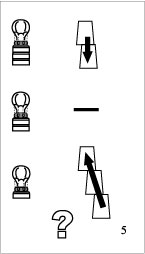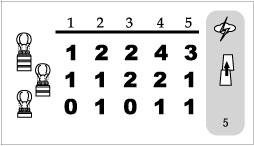The player whose turn it is always uses his own cards. Two choices are available:
- Play a card to move your own balloon, OR
- Play a card from the table on another's balloon.
A. Play a card to move your own balloon:
The player plays one of his Local Wind cards from his hand openly on the table in front of him and follows the instructions (more about these later). The card stays in front of the player even after his turn. But: If you already have 3 played cards in front of you, you must choose option B -- you may not play a card on your own balloon.B. Play a card from the table on another's balloon:
One of the Local Wind cards currently in front of the player may be played on another player's balloon, i.e., on one of the two balloons whose Wind Rose colors currently have pawns. The choice between the two is taken by the player of the card (if one of the marked colors is his own he must choose the other balloon).Resolving the Card:The card's instructions are now applied to the chosen balloon. After this the pawn is advanced to the next unoccupied Wind Rose point in a counter-clockwise direction. Wind Rose colors already having a pawn are skipped, as are colors corresponding to balloons not in the game. Finally, the used card is placed in the discard pile.
The affected player cross-references the balloon's current altitude with the card and applies the instruction to move the balloon north or south accordingly. A balloon moving northward or southward maintains its relative distance to the next heavy line. In other words, balloons moving south move right while balloons moving north move left. An exception is that balloons moving north or south never cross a heavy red or blue line.A Local Wind card may have no instructions, i.e. simply a dash (-), at the altitude of the affected balloon. In this case the card has no effect.
Example Local Wind Card:

On this card, if the balloon were at High altitude it would be moved one space south. At Medium altitude the balloon would not have any movement at all.
If at Low altitude it would be moved two spaces north.
The "?" symbol indicates that this card may be played to generate a Misfortune instead of movement.
A few cards also show the "?" Misfortune symbol. In this case, the player of the card may choose to apply a Misfortune card instead of north-south movement. To resolve this, simply draw the top card from the Misfortune deck and resolve per the card's instructions. (Should the Misfortune deck become depleted, simply re-shuffle the discards to form a new deck.)
A few cards also show the quartered-circle Quadrant symbol. In this case, the player of the card may choose to change the Quadrant card in the target balloon's quadrant instead of applying north-south movement. To resolve this, draw the top card from the Quadrant deck and place it on top of the current card for that Quadrant. (Should the Quadrant deck become depleted, re-shuffle the discards and not visible cards to form a new deck.)
If a balloon is moved into the Polar Vortex, it returns to the race in Lane 1, but it is placed in the first space after the last heavy red or blue line that the balloon has passed. If a balloon is moved into the Equatorial Doldrums, it is placed just outside the space from which it departed Lane 5 and remains there until a Local Wind card is played to move it back into the race. Balloons which are Grounded, such as on the first turn of the game, do not have any north-south movement.
Special use of Advantage Cards: If a player no longer wishes to hold a particular Advantage card, he may discard it after playing any Local Wind card. In exchange, he may pick up a Local Wind card from any of those face up on the table, including his own (but not from the discard pile). This card is added to the player's hand.
A balloon may change its altitude to any one of 4 levels: High, Medium, Low or Grounded. A balloon's altitude is represented by use of the altitude adjusters. Players stack up adjusters and then fit the balloon over this assembly. To show the balloon at Low altitude, place it on a single adjuster. To show Medium altitude, add a second adjuster. Add a third adjuster to show High altitude. Balloons may only have all of the adjusters removed, i.e. Grounded, if so instructed by the rules.
To increase altitude: discard one Ballast chip per level ascended.
To decrease altitude: discard one Gas chip per level descended.
Balloons move in a counter-clockwise direction. Cross-reference your current altitude and lane with the card corresponding to the balloon's quadrant to determine how many spaces your balloon moves. Positive numbers indicate forward movement while negative numbers indicate backward movement. A "0" (zero) indicates that the balloon does not have any movement.
Note that Quadrant cards have extra instructions along the right hand edge which are used only in conjunction with certain Misfortune cards. This information should be otherwise ignored.
Example Quadrant card:

|
If traveling in the Quadrant of this card, a balloon at High altitude in Lane 4 would move forward (counter-clockwise) 4 spaces. The symbols at the right side of the card are used in conjunction with the Bad Weather Misfortune card (see more below). |
Exclusion Zones.
Unless the owning player has the matching
Permission Advantage card face up in front of himself at the moment of entry,
balloons which enter the yellow spaces
representing the restricted airspaces of Libya, Iraq, Sakhalin Island,
Area 51 (has no permission card) or the
People's Republic of China
must immediately expend Gas chips to become Grounded (in the offending zone).
The player loses the next turn.
Then on the following turn, the balloon may launch again either from the space
or from the leftmost space which is one lane north or south
of this space, at the player's discretion.
Mountain Zones.
The spaces containing brown or white triangles indicate mountain zones.
Brown mountain zones must be traversed at Medium
or High altitude while White mountain zones must be traversed at High altitude.
A balloon which fails to observe the mountain zone altitude requirements is
automatically considered Grounded and the player loses the next turn.
Then on the following turn, the balloon may launch again as normal either from the space
or from the leftmost space which is one lane north or south
of this space, at the player's discretion.
A balloon at High altitude must expend one fuel chip if any are available. If unable to spend the fuel chip, it automatically loses a level (without expending any chips).
A balloon which has no remaining Gas must expend one fuel chip if any are available. If unable to spend the fuel chip, it automatically loses a level (without expending any chips).
If you have only 2 cards in your hand, draw another card from the Local Wind card deck. (If the deck is depleted, gather up all the discards and re-shuffle.)










